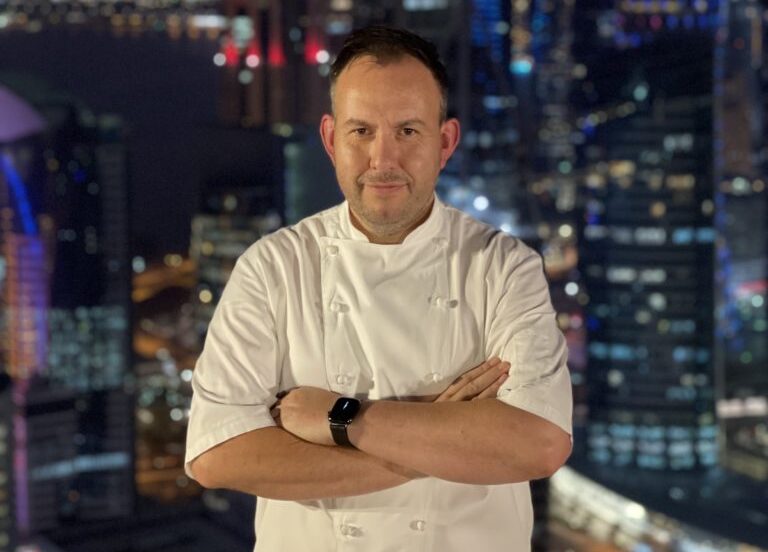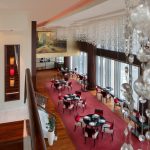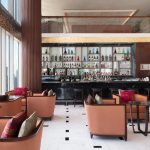
With a career spanning some 24 years Chef Peter Lloyd has a host of prestigious accolades under his belt, holding senior roles in some of London’s most glamorous kitchens such as the Dorchester Hotel on Park Lane.
In 2011 Peter Lloyd took the helm as Executive Chef of Spice Market at The W Hotel, a concept created by world renowned 3 Michelin Star Chef Jean-Georges Vongerichten. Chef Peter has appeared on numerous TV shows including Saturday Kitchen, BBC Celebrity Masterchef and Junior Bake off. He regularly travels abroad promoting the best of South-East Asian food. His recent pop ups include Abu Dhabi, Bangkok, Bali and the World St Food Congress in Singapore, Philippines and currently in Doha.
The menu created by Chef Peter Lloyd for Shanghai Club at the JW Marriott Marquis City Center Doha is built around a single common thread: a creative universe that draws from his travels, spices, and emotions – abstract, conceptual, yet enveloping as a comfort blanket on rainy days.
Excerpts from our interview with the taste maker during his visit for a unique culinary experience.
How did the collaboration with Shanghai Club at JW Marriott Marquis come about?
I worked with Esra Parin (Editor’s note: the hotel General Manager) when I was the head chef at the W London for Jean-Georges for 5 years. While training for the Spice Market, we realised there was an opportunity to do more in terms of activations and pop-ups due to my presence on social media and interaction with the locals. For the next 4 to 5 years I returned for promotions, receiving excellent coverage. I then opened my own restaurant in London which was a success. I assisted Esra Parin when she opened the W hotel in Amman, Jordan, as a consultant for both the Asian restaurant and all-day dining restaurant. This equation proved to be very successful and a perfect partnership with the transition of the Shanghai Club, using my experience of Doha. It’s been an incredible week, with positive feedback and I foresee exciting times ahead.
You have worked for the biggest institution in the UK under famous chefs. How did this influence your cuisine?
I always felt that once I realised that I wanted to become a professional chef and got to understand the different levels of cooking – in London in particular.
You can be a chef and work in a hospital, a school, a café, brasserie or a 5 stars hotel or even better a Michelin star restaurant – there are so many different levels, yet all these chefs are quite unique in their own style. Wanting to work at the best places, I found myself at the Dorchester Hotel on Park Lane and this started to shape the level that I wanted to cook at, but I was still cooking modern European cuisine and went on to run some great restaurants in London. It was only when I joined the Sanderson Hotel with its modern Malaysian style restaurant that I started to transition –The brief was to change this restaurant into a French-style tapas but the deal with the hotel and restaurant-group didn’t go through, so I inherited a Malaysian restaurant. I naturally took to the cuisine and every year I would go to Asia, whether it was Singapore, Malaysia, Indonesia or Hong-Kong. It was a natural shift, almost fate, that I was destined to cook the Malaysian cuisine. Two years later I joined Jean-Gorges and Spice Market and that’s where I really started to embrace how to take a traditional South-East Asian recipe and develop it while still respecting the boundaries of what that recipe is but with a modern twist that a contemporary diner would appreciate.
You were the head chef of Spice Market, how did that experience play out in your career?
It was pivotal because I joined Spice Market as the executive chef of a big busy restaurant – it was ahead of its time being one of the first restaurants in New York that embraced the sharing style concept, with the accompanying buzzing atmosphere. Dining at Spice Market wasn’t just about the food, it was about the culture, people, and atmosphere that one wanted to be a part of. I used to do 400 covers for dinner once I really got into understanding the concept, the style of cuisine and presentation. I followed the same style when I opened my own restaurant, Sticky Mango, in London. It’s obviously different as I founded it myself so it was a very humble beginning because you are used to working in a 5-star environment with maintenance, engineering, marketing…and when you open your own restaurant it’s like you fall to the bottom of the ladder – you know what you want to achieve so you build it up, bit by bit and that really paved the way forward for what I have today.
What exactly attracted you to South-Asian cuisine?
Most South Asian cuisine recipes are hundreds of years old, born out of poverty. We all know and love to eat street food when we are on holidays, but street food is a way of life for a lot of people. They would use the ingredients around them. If they were on a beach, they would get lemongrass, ginger and galangal, crushing it into a paste for their fresh fish, wrapped in a banana leaf. Barbecue this and they would have a queue of people. Alot of these recipes are old recipes, so we energize them, by using modern cooking techniques but still utilizing that original balance of flavours. The beautiful thing about my restaurant is that we don’t tie ourselves into one cuisine – there a ton of great Thai, Indonesian or Malaysian restaurants…For me it’s just South East Asian. The reason I do that is because I love them all and I don’t want to be tied down by one cuisine. I travel extensively and have done work for the ministry of Tourism in Indonesia and a food tour of Indonesian Cuisine. It was incredible and it meant that when I came back to my restaurant, I could take that experience and incorporate it into an Indonesian Menu tasting with new recipes and new ideas. Next time I go to Thailand or Vietnam I can do the same as it fits within the boundaries of what we are trying to achieve at the restaurant.
Take us through one of your signature recipes from its inception to being served in front of the guest.
I sometimes have to explain the madness behind what I am trying to do because there are a lot of things to take into consideration. While trying to create a story we need to be true to the original flavours and taste. I think a great example of this is the Pandan Macaron.
I feel that a lot of Asian restaurants struggle with their desserts. During a tour of Singapore I was cooking at a world street food fest and I went to visit a traditional coffee shop where they serve a dish called Kaya toast (ed Kaya toast is a dish consisting of two slices of toast with butter and kaya:coconut jam). It was curated by the Hines who used to work on the British trade ships. They saw the British people having their jam on toast and when they went back to their land they made their own version of jam using pandan with coconut sugar. It’s a green jam spread on toast with slices of butter served with four mini poached eggs on the side with soy sauce. So what I have done with this dessert is that we know the flavours work together, the pandan, the sandwich, the egg and the soy sauce but I transformed this dish into a dessert so instead of bread for the sandwich, you make a pandan macaron, the kaya jam we put inside the macaron and instead of the poached egg and soy sauce we make a fresh ice-cream using eggs and soy sauce. We have a soy sauce caramel ice cream which some people just can’t wrap their head around.
Dining out, travel and hospitality have been amongst the most disrupted industries by the pandemic. How did that play out for your own restaurant Sticky Mango?
It was a very stressful time as we just got our restaurant into a very good, strong position and then literally within a week we went from doing 140 covers for dinner to 10 – it was just like someone turned the tap off and the water stopped coming. It was very unnerving; I was very appreciative about what the British government did for our industry – it didn’t work for everybody but for us it was perfect as we got support to look after the staff without making any of them redundant. As we went through the first lockdown nobody really knew how long this was going to last. We managed to open again in July which gave us a chance to breathe again and get some cashflow back into the business until December which was very difficult but again, we were supported with business grants and we survived. Since we reopened in May the restaurant has been busier than ever, so we are in a really good place – it is a hugely rewarding experience to have gone through – it was difficult and stressful at the time but looking back now it just makes you appreciate everything so much more and to not take anything for granted. It doesn’t matter how successful you are even the biggest names in the industry got hit hard and it’s going to take a while to recover. Hence, we got to look after every body and stay humble.
Any cuisine you would like to touch upon that you haven’t already?
My partner is Italian, and I love Italian food. It’s just fantastic simple food, the simplicity of it lies in the quality of the ingredients. We have a place on the Amalfi Coast, and I always look forward to our trips there. During lockdown I discovered the art of sourdough and pizza-making and I have mastered the art of pizza. From a professional point of view, the cuisine for me which I hope my next restaurant concept will be dedicated to, is Indonesian-it’s such a hidden treasure. They have over 4500 listed official recipes and yet people can probably name 3 or 4 dishes – it’s so underrepresented.
Vietnam is also on top of my list as I would like to discover more of their cuisine – I have recipes, but I want to live it, feel it and smell it because when you can do that, you can translate it much better.
What are your views on Qatar’s gastronomic scene?
Qatar seems to have the best of everything. If you look at the list of restaurants, it’s spectacular. The last time I was here in 2015 and the level was already high – the environment becomes a whole new experience; give it a panoramic view and you have an elevated meal. When you have a high-profile restaurant, that has a part brand or where a particular standard has been set it just needs follow-ups and trainings. You need to come 3-4 times a year, training, re-training, checking recipes, making sure ingredients haven’t been changed and that’s the secret to the consistency that makes a great restaurant.
You just took part in a singular experience: cooking contest with Doha-based influencers/public figures at 190m above sea level: tell us a bit more about it?
Lina Qishawi and Khalifa Al-Haroon were great. Lina was a really good sport: she was fun, she embraced it but didn’t take it too seriously while doing a great job despite the difficult nature of the challenge. Khalifa was fantastic: he was funny, engaging and his descriptions were spot on. He did extremely well while sitting on the rooftop overlooking Doha’s skyline – the scene was quite memorable and dramatic. These 10 days that I have been here made me feel like I never left. The 2-days pop-up menu tasting is sold-out, so we definitely made an impact and hopefully build on that to make something more permanent.
I have had the pleasure to be at the Chef’s table to preview the 10-course feast. How was the feedback from my fellow guests?
Feedback has been positive, and it was very well received. There was an air of excitement about what can potentially happen with so many concepts and ideas in a stunning environment.
Asians love whole fish, but it can be messy with little bones so for my diners I didn’t want them to feel embarrassed or uncomfortable when eating so we serve the fish whole. It looks very dramatic, but we fillet the fish half way up to the head but keep it attached so that it falls around and it looks amazing when it goes into the restaurant – it’s a real head-turner! You get to enjoy the whole fish experience with none of the little disagreements. These are the kind of details and tweaks that allow us to deliver a fantastic menu. We would absolutely be a game changer in the dining scene of Doha.
Written by Narges Raiss



